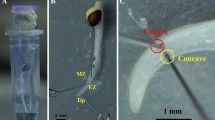Abstract
1. The uptake of indol-3-yl acetic acid ([1-14C]IAA, 0–2.0 μM) into light-grown pea stem segments was measured under various conditions to investigate the extent to which mechanisms of auxin transport in crown gall suspension culture cells (Rubery and Sheldrake, Planta 118, 101–121, 1974) are also found in a tissue capable of polar auxin transport. — 2. IAA uptake increased as the external pH was lowered. IAA uptake was less than that of benzoic acid (BA), naphthylacetic acid (NAA) or 2,4 dichlorophenoxyacetic acid (2,4D) under equivalent conditions. TIBA enhanced net IAA uptake through inhibition of efflux, and to a lesser extent, also increased uptake of NAA and 2,4D while it had no effect on BA uptake. — 3. Both DNP and, at higher concentrations, BA, reduced IAA uptake probably because of a reduction of cytoplasmic pH. However, low concentrations of both BA and DNP caused a slight enhancement of IAA net uptake, possibly through a reduction of carrier-mediated IAA efflux. In the presence of TIBA, the inhibitory effects of DNP and BA were more severe and there was no enhancement of uptake at low concentrations. — 4. Non-radioactive IAA (10 μM) reduced uptake of labelled IAA but further increases in concentration up to 1.0 mM produced first an inhibition (0–10 min) of labelled IAA uptake, followed by a stimulation at later times. Non-radioactive 2,4 D decreased, but was not observed to stimulate, uptake of labelled IAA. In the presence of TIBA labelled IAA uptake was inhibited by non-radioactive IAA regardless of its concentration. — 5. Sulphydryl reagents PCMB and PCMBS promoted or inhibited IAA uptake depending, respectively, on whether they penetrated or were excluded from the cells. The penetrant PCMB also reduced the promotion of labelled IAA uptake by TIBA or by high concentrations of added non-labelled IAA. — 6. Our findings are interpreted as being consistent with the diffusive entry of unionised IAA into cells together with some carrier-mediated uptake. Auxin efflux from the cells also appears to have a carrier-mediated contribution, at least part of which is inhibited by TIBA, and which has a capacity at least as great as that of the uptake carrier. The data indicate that pea stem segments contain cells whose mechanisms of trans-membrane auxin transport fit the model of polar auxin transport proposed from experiments with crown gall suspension cells, although differences, particularly of carrier specificity, are apparent between the two systems.
Similar content being viewed by others
Abbreviations
- IAA:
-
indol-3-yl acetic acid
- BA:
-
benzoic acid
- NAA:
-
1-naphthylacetic acid
- 2,4-D:
-
2,4-dichlorophenoxyacetic acid
- TIBA:
-
2,3,5-triiodobenzoic acid
- DNP:
-
2,4-dinitrophenol
- PCMB:
-
p-chloromercuribenzoic acid
- PCMBS:
-
p-chloromercuribenzene sulphonic acid
References
Davies, P.J.: The fate of exogenously applied indoleacetic acid in light grown stems. Physiol. Plant. 27, 262–270 (1972)
Davies, P.J.: The uptake and fractional distribution of differentially labeled indoleacetic acid in light grown stems. Physiol. Plant. 28, 95–100 (1973)
Davies, P.J.: The uptake and elution of indoleacetic acid by pea stem segments in relation to auxin induced growth. In: Plant growth substances, pp. 767–779, Sumiki, Y., ed. Tokyo: Hirokawa Publishing Co. 1974
Felle, H., Bentrup, F.W.: A study of the primary effect of the uncoupler carbonyl cyanide m-chlorophenylhydrazone on membrane pontential and conductance in Riccia Fluitans. Biochim. Biophys. Acta 464, 179–187 (1977)
Goldsmith, M.H.M.: The polar transport of auxin. Ann. Rev. Plant Physiol. 28, 439–478 (1977)
Humphreys, T.E.: Dinitrophenol-induced hydrogen-ion influx into maize scutellum. Planta 127, 1–10 (1975)
Kotyk, A., Jánaček, K.: Cell membrane transport: Principles and techniques. New York, London: Plenum Press 1970
Leguay, J.J.: The 5,5-dimethyloxazolidine-2[14C], 4-dione distribution technique and the measurement of intracellular pH in Acer pseudoplatanus cells. Biochim. Biophys. Acta 497, 329–333 (1977)
Leopold, A.C., Lam, S.L.: Polar transport of three auxins. In: Plant Growth Regulation, pp. 411–418. 4th Intern. Conf. Plant Growth Regulation, Klein, R.M., ed. Ames: Iowa State Univ. Press 1961
Morris, D.A.: Transport of exogenous auxin in two-branched dwarf pea seedlings (Pisum sativum L.). Planta 136, 91–96 (1977)
Morris, D.A., Thomas, A.G.: A microradioautographic study of auxin transport in the stems of intact pea seedlings (Pisum sativum L.). J. Exp. Bot. 29, 147–157 (1978)
Raven, J.A.: Transport of indoleacetic acid in plant cells in relation to pH and electrical potential gradients and its significance for polar IAA transport. New Phytol. 74, 163–172 (1975)
Rubery, P.H.: The specificity of carrier-mediated auxin transport by suspension-cultured crown gall cells. Planta 135, 275–283 (1977)
Rubery, P.H.: Hydrogen ion dependence of carrier-mediated auxin uptake by suspension cultured crown gall cells. Planta 142, 203–206 (1978)
Rubery, P.H., Sheldrake, A.R.: Effect of pH and surface charge on cell uptake of auxin. Nature New Biol. 244, 285–288 (1973)
Rubery, P.H., Sheldrake, A.R.: Carrier mediated auxin transport. Planta 118, 101–121 (1974)
Scott, T.K., Briggs, W.R.: Auxin relationships in the alaska pea (Pisum sativum). Am. J. Bot. 47, 492–498 (1960)
Venis, M.A.: Affinity labels for auxin binding sites in corn coleoptile membranes. Planta 134, 145–149 (1977)
Wangerman, E.: The pathway of transport of applied indolylacetic acid through internode segments. New Phytol. 73, 623–636 (1974)
Author information
Authors and Affiliations
Additional information
This work was performed in Cambridge during the tenure of a sabbatical leave by P.J.D. Supported by a grant for supplies from the American Philosophical Society to P.J.D.
Rights and permissions
About this article
Cite this article
Davies, P.J., Rubery, P.H. Components of auxin transport in stem segments of Pisum sativum L.. Planta 142, 211–219 (1978). https://doi.org/10.1007/BF00388215
Received:
Accepted:
Issue Date:
DOI: https://doi.org/10.1007/BF00388215




